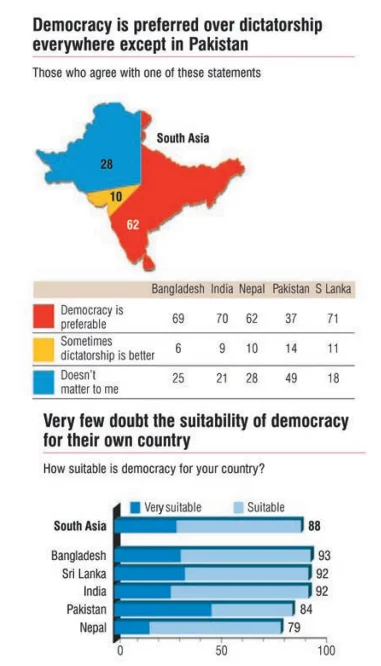![]() 22 Jul 2024
22 Jul 2024
‘South Asia’ usually includes the following countries: Bangladesh, Bhutan, India, the Maldives, Nepal, Pakistan and Sri Lanka. The boundaries of the region are not as clear in the east and the west, as they are in the north and the south. Afghanistan and Myanmar are often included in discussions of the region as a whole. Pakistan and Bangladesh have experienced both civilian and military rulers. Nepal was a constitutional monarchy with the danger of the king taking over executive powers. In 2008, the monarchy was abolished and Nepal emerged as a democratic republic.
When India and Pakistan joined a club of nuclear powers, this region suddenly became the focus of global attention. The focus was, of course, on the various kinds of conflict in this region, there are pending border and water-sharing disputes between the states of the region. Besides, there are conflicts arising out of insurgency, ethnic strife and resource sharing.

| Timeline of South Asia Since 1947 |
| 1947: India and Pakistan emerge as independent nations after the end of British rule |
| 1948: Sri Lanka (then Ceylon) gains independence; Indo-Pak conflict over Kashmir |
| 1954-55: Pakistan joins the Cold War military blocs, SEATO and CENTO |
| 1960: India and Pakistan sign the Indus Waters Treaty |
| 1962: Border conflict between India and China 1965: Indo-Pak War; UN India-Pakistan Observation Mission |
| 1966: India and Pakistan sign the Tashkent Agreement; Six-point proposal of Sheikh Mujib-ur Rahman for greater autonomy to East Pakistan |
| 1971 March: Proclamation of Independence by leaders of Bangladesh August: Indo-Soviet Treaty of Friendship signed for 20 years December: Indo-Pak War, Liberation of Bangladesh |
| 1972 July: India and Pakistan sign the Shimla Agreement |
| 1974 May: India conducts nuclear test |
| 1976: Pakistan and Bangladesh establish diplomatic ties |
| 1985 December: South Asian leaders sign the SAARC Charter at the first summit in Dhaka |
| 1987: Indo-Sri Lanka Accord; Indian Peace Keeping Force (IPKF) operation in Sri Lanka (1987-90) |
| 1988: India sends troops to the Maldives to foil a coup attempt by mercenaries India and Pakistan sign an agreement not to attack nuclear installations and facilities of each other |
| 1988-91: Democracy restoration in Pakistan, Bangladesh and Nepal |
| 1996 December: India and Bangladesh sign the Farakka Treaty for sharing of the Ganga Waters |
| 1998 May: India and Pakistan conduct nuclear tests December: India and Sri Lanka sign the Free Trade Agreement (FTA) |
| 1999 February: Indian PM Vajpayee undertakes a bus journey to Lahore to sign a Peace Declaration |
| June-July 1999: Kargil conflict between India and Pakistan |
| 2001 July: Vajpayee – Musharraf Agra Summit unsuccessful |
| 2004 January: SAFTA signed at the 12th SAARC Summit in Islamabad |
| 2007: Afghanistan joined SAARC |
| 2014 November: The 18th SAARC Summit in Kathmandu, Nepal |
East Pakistan Under Pakistani Rule: Bangladesh was a part of Pakistan from 1947 to 1971. It consisted of the partitioned areas of Bengal and Assam from British India.
Historical Overview: Nepal was a Hindu kingdom in past and then a constitutional monarchy in modern period for many years.
Democracy and Ethnic Conflict: Sri Lanka has retained democracy since its independence in 1948. But it faced a serious challenge, not from military or monarchy but rather from ethnic conflict leading to demand for secession by one of the regions.
Kashmir Dispute: After independence, the Pakistani government claimed that Kashmir belonged to it. Wars between India and Pakistan in 1947-48 and 1965 failed to settle matters.
| Must Read | |
| Current Affairs | Editorial Analysis |
| Upsc Notes | Upsc Blogs |
| NCERT Notes | Free Main Answer Writing |
South Asia’s geopolitical landscape has been marked by significant political transformations, regional conflicts, and evolving democratic practices. While India and Pakistan’s nuclear capabilities have drawn global focus, the region’s internal dynamics reveal a complex interplay of military interventions, democratic transitions, and ethnic conflicts. Countries like Nepal, Bangladesh, and Sri Lanka have navigated unique paths toward democracy amidst challenges. Despite persistent disputes, especially between India and Pakistan, South Asia continues to evolve, reflecting both historical legacies and aspirations for stability and development.
| Related Articles | |
| Places In News: Democratic Republic of Congo | Relations of British India with Neighboring Countries |
| List of Joint Military Exercises of India | Indus Waters Treaty |
<div class="new-fform">
</div>